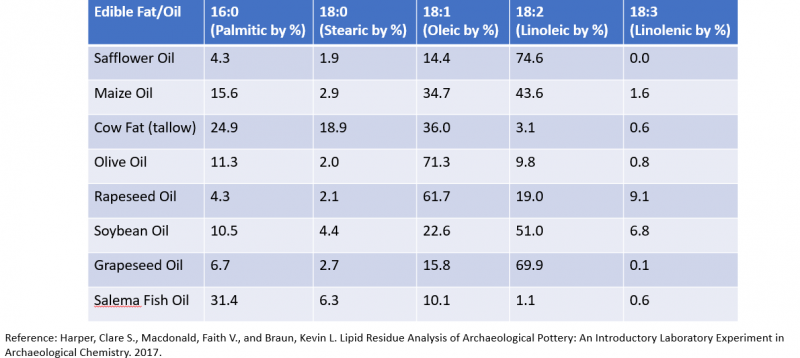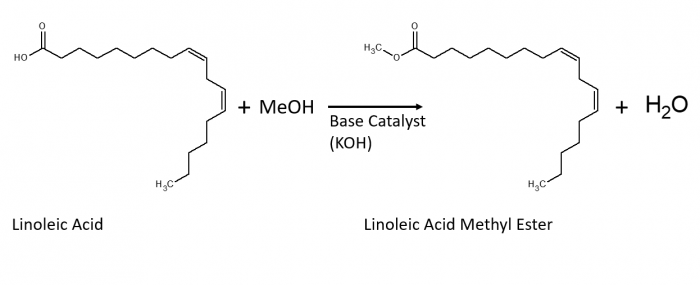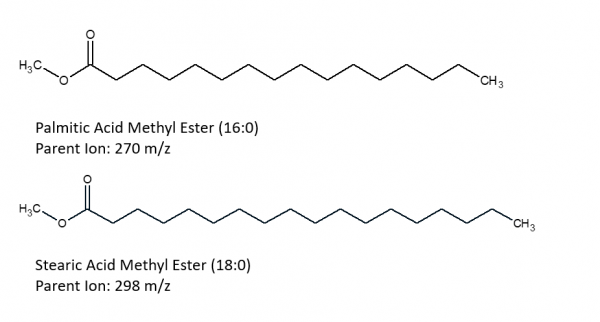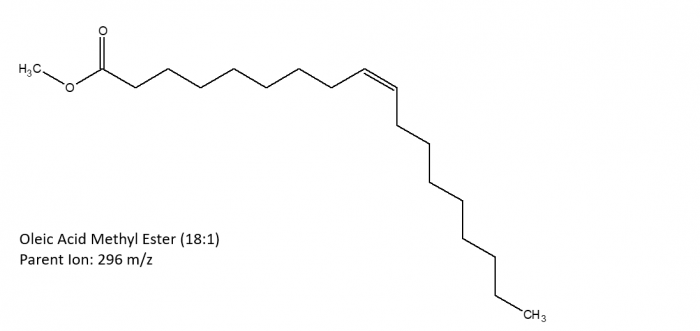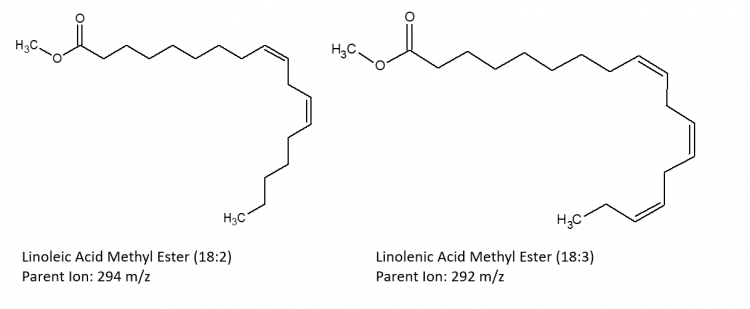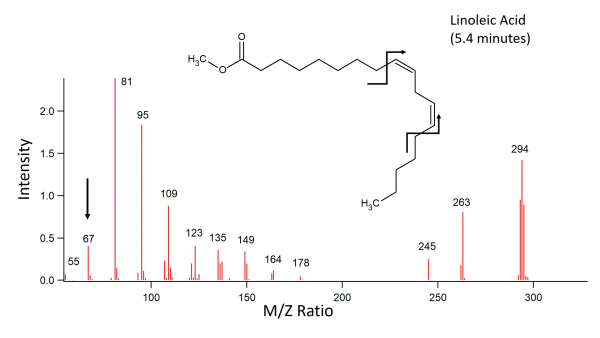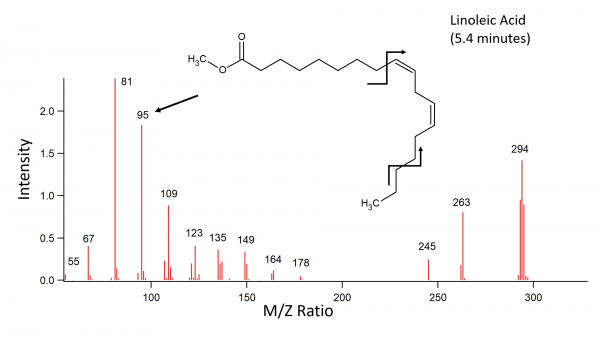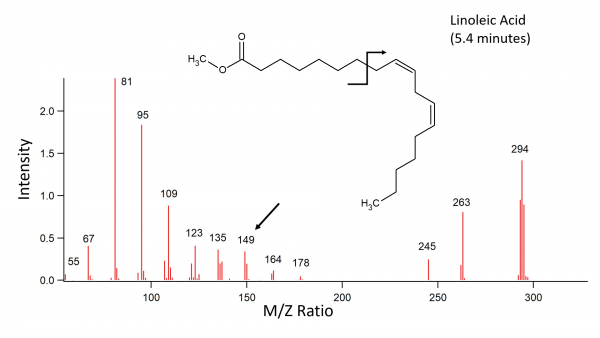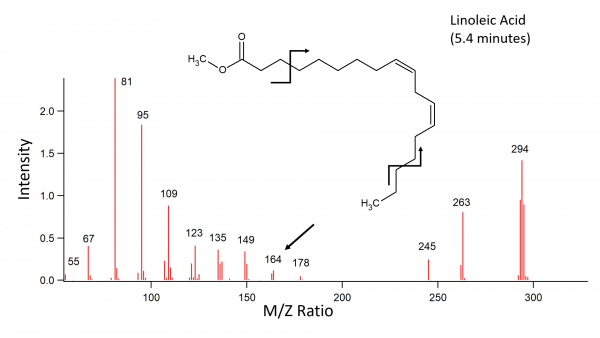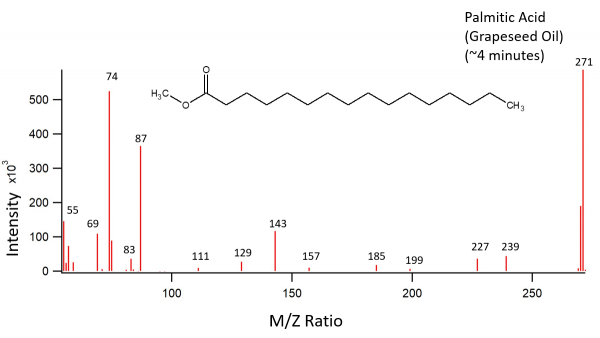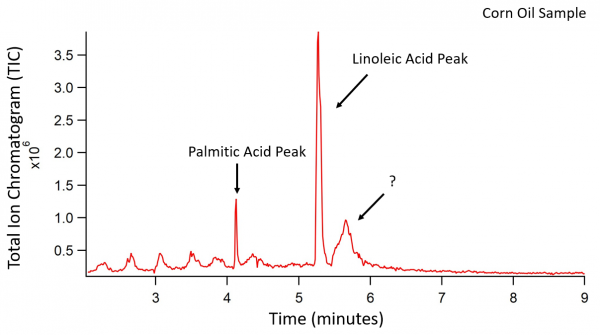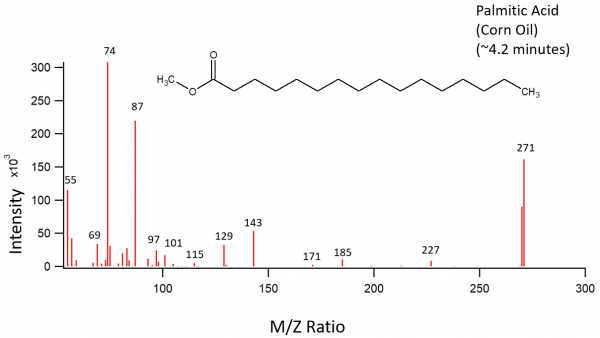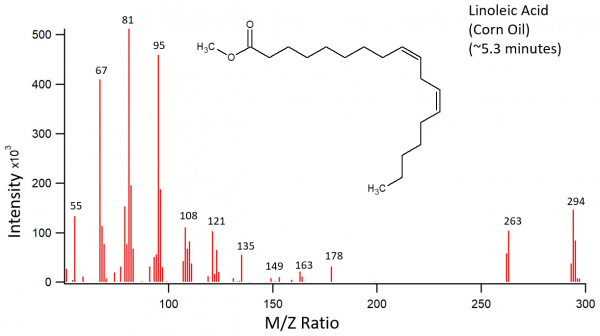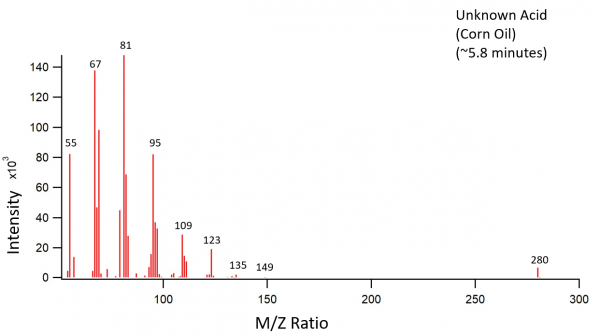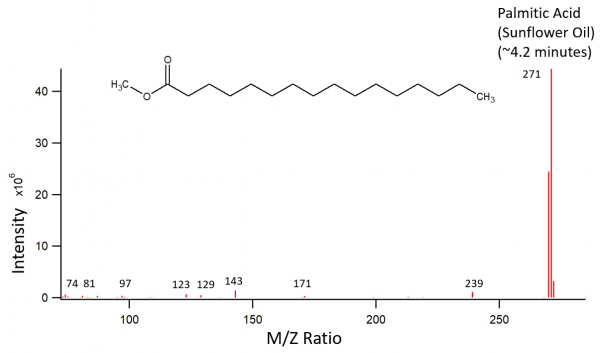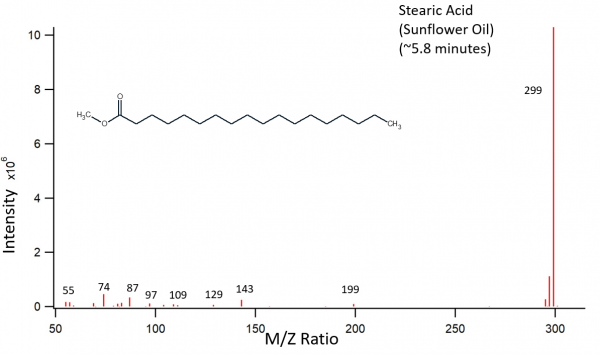Difference between revisions of "Fatty Acid Methyl Esters"
| (105 intermediate revisions by one other user not shown) | |||
| Line 1: | Line 1: | ||
| + | ''<small>The following document was completed by Joise K. Welker in Spring of 2021 in partial fulfillment of her requirements for a Bachelor's Degree of Science in Biochemistry, Monmouth College, Monmouth, Il 61462. The research was done under the supervision of Bradley E. Sturgeon.</small>'' | ||
==Introduction== | ==Introduction== | ||
| − | The | + | Archaeology is the study of human societies through the analysis of material remains (1). The analysis of material remains can be done through many different processes and can reveal the purpose and origin of each material. The introduction of analytical chemistry techniques into the field of archaeology has allowed archaeologists to gain an even deeper understanding of any given material. The procedure described in this experiment is one such technique. This experiment uses gas chromatography-mass spectrometry to identify the origins of a variety of fatty acids in a sample. Humans modify the chemical composition of everything around them through daily activities such as collecting and preparing food, the use of specific pigments and dyes, and a variety of other practices (2). The chemical composition of different material remains can therefore tell a story about the people who used these materials, such as their food practices and diets (3). Dried clay used by humans of the past holds lipid residue fairly well. If this clay is pulverized and treated with solvent extraction, the sample can undergo GC-MS analysis. Through this analytical technique the fragmentation patterns of each oil can be obtained, allowing for the identification of all the oils in the sample. Every type of oil has a specific combination of fatty acids that comprise the chemical makeup of said oil. Comparing fatty acid composition to previously established oil composition data can help identify which types of oil are in the samples. A similar process can be done with modern-day cooking oils to compare their fatty acid oil composition to current oil composition data. This experiment analyzes the fatty acid composition of grapeseed oil, corn oil, and sunflower oil. The fatty acids focused on in this study were palmitic acid, oleic acid, stearic acid, linoleic acid, and linolenic acid. The procedure used in this experiment was based on the procedure in an experiment created by Harper et. al (4). |
| + | |||
| + | Fatty acid content can be used to help identify the origins of different types of oils. Each type of oil has a unique amount of different fatty acids. Unsaturated fatty acids are more common in plant materials, while saturated fatty acids are more common in animal fats. A higher degree of unsaturated fatty acids in oils make the oil more susceptible to oxidative deterioration (5). Unsaturated fatty acids also have a lower melting point than saturated fatty acids of a similar length (6). This makes saturated fatty acid oils more stable than unsaturated fatty acid oils (7). Certain plant materials are known to be used for tasks such as dyeing fabrics, so being able to tell what type of plant each pot was used for can determine the purpose of each pot. These values can help archaeologists determine what kind of material a pot was used for if the pot is crushed up and sent in for GC-MS analysis. This is just one of the many applications this fatty acid methyl ester GC-MS analysis technique has in a variety of disciplines. Figure 1. shows some experimental values of fatty acid content in different types of oils. | ||
| + | |||
| + | [[File:2021-04-13 (4).png|800px|thumb|left|Figure 1. is a table depicting the experimental values of fatty acid content in different types of fats and oils.]] | ||
| + | |||
| + | |||
| + | |||
| + | |||
| + | |||
| + | |||
| + | |||
| + | |||
| + | |||
| + | |||
| + | |||
| + | |||
| + | |||
| + | |||
| + | |||
| + | |||
| + | |||
| + | |||
| + | |||
| + | |||
| + | |||
| + | |||
| − | |||
| − | |||
| − | |||
| − | |||
| − | |||
| − | |||
| − | |||
| − | |||
| − | |||
| − | |||
| − | |||
| − | |||
==Methods and Materials== | ==Methods and Materials== | ||
===Materials=== | ===Materials=== | ||
| − | '''Samples''' | + | '''Oil Samples''' |
All samples were obtained from Monmouth College's nutrition laboratory. The grapeseed oil was the brand Carlini. The sunflower oil was virgin sunflower oil of the brand Authentic Menu. The corn oil was "pure" corn oil of the brand Essential Everyday. | All samples were obtained from Monmouth College's nutrition laboratory. The grapeseed oil was the brand Carlini. The sunflower oil was virgin sunflower oil of the brand Authentic Menu. The corn oil was "pure" corn oil of the brand Essential Everyday. | ||
| Line 29: | Line 44: | ||
'''Chemicals''' | '''Chemicals''' | ||
| − | + | Methanol, KOH, pentane, and acetic acid were all purchased from Millipore Sigma. | |
| + | |||
| + | ===Sample Preparation/Transesterifcation=== | ||
| + | |||
| + | Before an oil sample can be detected by GC-MS analysis, the fatty acids must be methylated to increase their volatility. The process by which this is done is called transesterification. The methyl from the methanol group is added to the carboxylic acid of the fatty acid to create a fatty acid methyl ester. | ||
| + | |||
| + | [[File:2021-04-13.png|700px|thumb|left|Figure 2. shows the transesterification process of linoleic acid to linoleic acid methyl ester.]] | ||
| + | |||
| + | |||
| + | |||
| + | |||
| + | |||
| + | |||
| + | |||
| − | |||
| − | |||
| − | |||
| − | After centrifugation, 40 ul of the top layer of each solution was removed and added to a GC vial. Each vial was then diluted with 40 ul of pentane for GC-MS analysis. | + | |
| + | |||
| + | |||
| + | |||
| + | |||
| + | |||
| + | |||
| + | |||
| + | |||
| + | |||
| + | |||
| + | |||
| + | |||
| + | |||
| + | Figures 3, 4, and 5 depict the chemical structures of the fatty acid methyl esters that have been detected in the samples. These images were created using ChemSketch. | ||
| + | |||
| + | {| | ||
| + | |[[File:2021-04-13 (1).png|600px|thumb|left|Figure 3. shows the chemical structures of palmitic acid methyl ester and stearic acid methyl ester ]] | ||
| + | || | ||
| + | |[[File:2021-04-13 (2).png|700px|thumb|left|Figure 4. shows the chemical structure of oleic acid methyl ester.]] | ||
| + | |} | ||
| + | [[File:2021-04-13 (3).png|750px|thumb|left|Figure 5. shows the chemical structure of linoleic acid methyl ester and linolenic acid methyl ester.]] | ||
| + | |||
| + | |||
| + | |||
| + | |||
| + | |||
| + | |||
| + | |||
| + | |||
| + | |||
| + | |||
| + | |||
| + | |||
| + | |||
| + | |||
| + | |||
| + | |||
| + | |||
| + | |||
| + | |||
| + | |||
| + | |||
| + | |||
| + | |||
| + | |||
| + | |||
| + | |||
| + | 200 ul of each sample was combined with 40 ul of anhydrous methanol into a microcentrifuge tube. Then 4.3 ul of 5 M KOH was added to the top methanol layer to act as a catalyst for the reaction. The microcentrifuge tubes were then sonicated in a Fisher Scientific model FS30H ultrasonic bath for 30 minutes. After being removed from the bath, 200 ul of 0.1 M acetic acid was added to each microcentrifuge tube to neutralize the base catalyst. Then each tube was centrifuged at 6,000 rpm for 5 minutes in a Capp Denmark model CR-68X tabletop microcentrifuge. After centrifugation, 40 ul of the top layer of each solution was removed and added to a GC vial. Each vial was then diluted with 40 ul of pentane for GC-MS analysis. | ||
==Results== | ==Results== | ||
===GC-MS Analysis=== | ===GC-MS Analysis=== | ||
| − | GC-MS | + | The Griffin 450 GC-MS with internal electron ionization, a polar capillary column, and a quadrupole ion trap analyzer was used to analyze the samples. The carrier gas used was helium. The injection port was maintained at 250°C and the injector port split ratio was 100:1. The detector temperature was set at 300°C and the final column temperature was set at 250°C and was set to be held for a minimum of 4 minutes. The column pressure was 18 psi. The initial oven temperature was set to 180°C and the oven temperature ramp was set for 20°C/min up to 250°C where it held for 5.5 minutes. The total analysis time for the samples on the GC-MS was about 9 minutes. The GC-MS method used was based upon the method created by Harper et. al in the supporting materials of their experiment (8). |
| + | |||
| + | The mass spectra results were used to identify the fatty acid of each chromatogram peak. The fragmentation patterns match up with each line on a mass spectrum. Below are examples of some of the fragmentation patterns for linoleic acid in the grapeseed oil sample. The pieces of the chemical structure between each set of arrows represents the fragment, and an arrow on the mass spectrum shows the corresponding peak. | ||
| + | |||
| + | {| | ||
| + | |[[File:2021-05-08 (1).png|600px|thumb|left|Figure 6. The fragmentation pattern at a m/z of 67.]] | ||
| + | || | ||
| + | [[File:2021-05-08 (2).png|600px|thumb|left|Figure 7. The fragmentation pattern at a m/z of 81.]] | ||
| + | |} | ||
| + | |||
| + | {| | ||
| + | |[[File:2021-05-08 (3).png|600px|thumb|left|Figure 8. The fragmentation pattern at a m/z of 95.]] | ||
| + | || | ||
| + | |[[File:2021-05-08 (4).png|600px|thumb|left|Figure 9. The fragmentation pattern at a m/z of 109.]] | ||
| + | |} | ||
| + | |||
| + | {| | ||
| + | |[[File:2021-05-08 (5).png|600px|thumb|left|Figure 10. The fragmentation pattern at a m/z of 149.]] | ||
| + | || | ||
| + | |[[File:2021-05-08 (6).png|600px|thumb|left|Figure 11. The fragmentation pattern at a m/z of 164.]] | ||
| + | |} | ||
====Grapeseed Oil Data==== | ====Grapeseed Oil Data==== | ||
| − | Grapeseed oil | + | Grapeseed oil underwent the sample preparation and transesterification described above. Figure 6. shows the chromatogram of the transesterification products of the grapeseed oil. Figures 7, 8, and 9 show the mass spectra of each of these peaks. |
{| | {| | ||
| − | |[[File:2021-04-19 (3).png|600px]] | + | |[[File:2021-04-19 (3).png|600px|thumb|left|Figure 12. The transesterification products of grapeseed oil: palmitic acid, linoleic acid ,and oleic acid.]] |
|| | || | ||
| − | [[File:2021-04-13 (11).png|600px]] | + | [[File:2021-04-13 (11).png|600px|thumb|left|Figure 13. The mass spectrum of the palmitic acid peak in the grapeseed oil sample.]] |
|} | |} | ||
{| | {| | ||
| − | |[[File:2021-04-13 (6).png|600px]] | + | |[[File:2021-04-13 (6).png|600px|thumb|left|Figure 14. The mass spectrum of the linoleic acid peak in the grapeseed oil sample.]] |
|| | || | ||
| − | |[[File:2021-04-13 (10).png|600px]] | + | |[[File:2021-04-13 (10).png|600px|thumb|left|Figure 15. The mass spectrum of the oleic acid peak in the grapeseed oil sample.]] |
|} | |} | ||
====Corn Oil Data==== | ====Corn Oil Data==== | ||
| − | Corn oil | + | Corn oil underwent the sample preparation and transesterification described above. Figure 10. shows the chromatogram of the transesterification products of the corn oil. Figures 11, 12, and 13 show the mass spectra of each of these peaks. |
| + | |||
{| | {| | ||
| − | |[[File:2021-04-19 (1).png|600px]] | + | |[[File:2021-04-19 (1).png|600px|thumb|left|Figure 16. The transesterification products of corn oil: palmitic acid, linoleic acid, and an unidentified acid.]] |
|| | || | ||
| − | |[[File:2021-04-18 (5).png|600px| | + | |[[File:2021-04-18 (5).png|600px|thumb|left|Figure 17. The mass spectrum of the palmitic acid peak in the corn oil sample.]] |
|} | |} | ||
{| | {| | ||
| − | |[[File:2021-04-18 (6).png|600px]] | + | |[[File:2021-04-18 (6).png|600px|thumb|left|Figure 18. The mass spectrum of the linoleic acid peak in the corn oil sample.]] |
|| | || | ||
| − | |[[File:2021-04-19.png|600px]] | + | |[[File:2021-04-19.png|600px|thumb|left|Figure 19. The mass spectrum of the unidentified acid peak in the corn oil sample.]] |
|} | |} | ||
====Sunflower Oil Data==== | ====Sunflower Oil Data==== | ||
| − | Sunflower oil | + | Sunflower oil underwent the sample preparation and transesterification described above. Figure 14. shows the chromatogram of the transesterification products of the sunflower oil. Figures 15, 16, and 17 show the mass spectra of each of these peaks. |
| + | |||
{| | {| | ||
| − | |[[File:2021-04- | + | |[[File:2021-04-26.png|600px|thumb|left|Figure 20. The transesterification products in the sunflower oil sample: palmitic acid, oleic acid, and stearic acid.]] |
|| | || | ||
| − | |[[File:2021-04-18 (1).png|600px]] | + | |[[File:2021-04-18 (1).png|600px|thumb|left|Figure 21. The mass spectrum of the palmitic acid peak in the sunflower oil sample.]] |
|} | |} | ||
{| | {| | ||
| − | |[[File:2021-04- | + | |[[File:2021-04-26 (1).png|600px|thumb|left|Figure 22. The mass spectrum of the oleic acid peak in the sunflower oil sample.]] |
|| | || | ||
| − | + | |[[File:2021-04-26 (2).png|600px|thumb|left|Figure 23. The mass spectrum of the stearic acid peak in the sunflower oil sample.]] | |
|} | |} | ||
==Discussion== | ==Discussion== | ||
| + | |||
| + | The results of this experiment show that this technique for analyzing fatty acid methyl-esters in oil samples will produce similar to expected values. Even though the fatty acids present in each sample were somewhat similar to the expected values, there were still quite a few discrepancies in chemical composition. In figure 12. the total ion chromatogram for grapeseed oil shows that this sample had a higher concentration of palmitic acid than oleic acid. According to the expected values for grapeseed oil, the oleic acid peak should have been much higher than the palmitic acid peak. Additionally, the oleic acid mpeak should come off the column before the linoleic acid peak because the oleic acid methyl ester should migrate faster from the polar column due to dipole-dipole interactions. The reason why the oleic acid methyl ester stuck to the column for longer than expected is unclear. However, the fragmentation patterns observed in figure 15. are consistent with the fragmentation of oleic acid, which reinforces the conclusion that this peak does represent oleic acid. The mass spectra for the fatty acids in the grapeseed oil were all consistent with expected fragmentation patterns for these fatty acids. | ||
| + | |||
| + | The corn oil data was the most difficult to analyze for several reasons, the most obvious being the amount of noise on the total ion chromatogram (figure 16.). While the palmitic acid and linoleic acid peaks were quite prominent, there are several other products with wide peaks throughout the chromatogram. This makes these peaks difficult to identify or determine the value of these peaks. The linoleic acid peak changes width throughout which creates issues with consistency in measurement. The palmitic acid (figure 17.) and linoleic acid (figure 18.) mass spectra had fragmentation patterns that were consistent with each respective fatty acid. The third peak which eluted after linoleic acid could not be matched to any of the five fatty acids referenced in this experiment. | ||
| + | |||
| + | The sunflower oil data also produced some unexpected results. The largest peak on the chromatogram should have been a linoleic acid peak according to previously recorded fatty acid contents of sunflower oil. Instead, the largest peak is oleic acid, which should have had a much lower content. The third peak is also much smaller than previous data would suggest, and is stearic acid. The stearic acid peak should be very small according to previous data. The largest peak appears to be split as well as wider than one would hope for a GC-MS chromatogram. This could be due to a possible overloading of the column with this particular sample. The palmitic acid mass spectrum (figure 21.) was consistent with the fragmentation patterns of palmitic acid. The oleic acid mass spectrum (figure 22.) possessed some of the fragmentation patterns expected with oleic acid but most importantly had a consistent parent ion. This was also the case for the stearic acid mass spectrum (figure 23.). | ||
| + | |||
| + | One possible reason for the unexpected results experienced with the corn and sunflower oil data is the oxidation degradation of the fatty acids. As previously mentioned, unsaturated fatty acids are more susceptible to oxidative degradation than saturated fatty acids and vegetable oils have more unsaturated fatty acids. The grapeseed oil was stored in a dark green glass bottle rather than a clear plastic bottle. While the age of the oils is unknown, the containers they were stored in could have had an impact on the oxidation process. In a repeated experiment the oils should be purchased with a similar age as well as all be stored in dark, tinted glass bottles to create more consistency. | ||
==References== | ==References== | ||
| − | [[:File:Lipid Residue Analysis.pdf|Lipid Residue Analysis of Archaeological Pottery: An Introductory Laboratory Experiment in Archaeological Chemistry | + | |
| − | + | [[:File:archaeological chemistry.pdf|[1] [2] Lambert, J. B. Archaeological Chemistry. ''Accounts of Chemical Research.'' '''2002''', ''35'', (8), 583-584.]] | |
| − | + | ||
| − | + | [[:File:gcms archaeology.pdf|[3] Chromatography and Archaeological Materials Analysis. ''The Encyclopedia of Archaeological Sciences,'' John Wiley & Sons, Inc. 2018. ]] | |
| + | |||
| + | [[:File:Lipid Residue Analysis.pdf|[4] Harper, C. S.; Macdonald, F. V.; Braun, K. L. Lipid Residue Analysis of Archaeological Pottery: An Introductory Laboratory Experiment in Archaeological Chemistry. ''J. Chem. Ed.'' '''2017''', ''94'', (9), 1309-1313.]] | ||
| + | |||
| + | [[:File:nutritional-value-fatty-acid-oils.pdf|[5] [6] [7] Kostik, V.; Memeti, S.; Bauer, B. Fatty Acid Composition of Edible Oils and Fats. ''J. Hygienic Engineering and Design.'' 112-116.]] | ||
| + | |||
| + | [[:File:lipid supporting materials.pdf|[8] Harper, C. S.; Macdonald, F. V.; Braun, K. L. Student Instructions. 1-7.]] | ||
| + | |||
| + | ==Science Seminar Presentation== | ||
| + | [[:File:Welker_Josie_Spring_Science_Sem.pptx|Welker, J. Science Seminar Presentation. Presented at Monmouth College, Monmouth, Illinois.]] | ||
Latest revision as of 13:12, 13 May 2021
The following document was completed by Joise K. Welker in Spring of 2021 in partial fulfillment of her requirements for a Bachelor's Degree of Science in Biochemistry, Monmouth College, Monmouth, Il 61462. The research was done under the supervision of Bradley E. Sturgeon.
Introduction
Archaeology is the study of human societies through the analysis of material remains (1). The analysis of material remains can be done through many different processes and can reveal the purpose and origin of each material. The introduction of analytical chemistry techniques into the field of archaeology has allowed archaeologists to gain an even deeper understanding of any given material. The procedure described in this experiment is one such technique. This experiment uses gas chromatography-mass spectrometry to identify the origins of a variety of fatty acids in a sample. Humans modify the chemical composition of everything around them through daily activities such as collecting and preparing food, the use of specific pigments and dyes, and a variety of other practices (2). The chemical composition of different material remains can therefore tell a story about the people who used these materials, such as their food practices and diets (3). Dried clay used by humans of the past holds lipid residue fairly well. If this clay is pulverized and treated with solvent extraction, the sample can undergo GC-MS analysis. Through this analytical technique the fragmentation patterns of each oil can be obtained, allowing for the identification of all the oils in the sample. Every type of oil has a specific combination of fatty acids that comprise the chemical makeup of said oil. Comparing fatty acid composition to previously established oil composition data can help identify which types of oil are in the samples. A similar process can be done with modern-day cooking oils to compare their fatty acid oil composition to current oil composition data. This experiment analyzes the fatty acid composition of grapeseed oil, corn oil, and sunflower oil. The fatty acids focused on in this study were palmitic acid, oleic acid, stearic acid, linoleic acid, and linolenic acid. The procedure used in this experiment was based on the procedure in an experiment created by Harper et. al (4).
Fatty acid content can be used to help identify the origins of different types of oils. Each type of oil has a unique amount of different fatty acids. Unsaturated fatty acids are more common in plant materials, while saturated fatty acids are more common in animal fats. A higher degree of unsaturated fatty acids in oils make the oil more susceptible to oxidative deterioration (5). Unsaturated fatty acids also have a lower melting point than saturated fatty acids of a similar length (6). This makes saturated fatty acid oils more stable than unsaturated fatty acid oils (7). Certain plant materials are known to be used for tasks such as dyeing fabrics, so being able to tell what type of plant each pot was used for can determine the purpose of each pot. These values can help archaeologists determine what kind of material a pot was used for if the pot is crushed up and sent in for GC-MS analysis. This is just one of the many applications this fatty acid methyl ester GC-MS analysis technique has in a variety of disciplines. Figure 1. shows some experimental values of fatty acid content in different types of oils.
Methods and Materials
Materials
Oil Samples
All samples were obtained from Monmouth College's nutrition laboratory. The grapeseed oil was the brand Carlini. The sunflower oil was virgin sunflower oil of the brand Authentic Menu. The corn oil was "pure" corn oil of the brand Essential Everyday.
Chemicals
Methanol, KOH, pentane, and acetic acid were all purchased from Millipore Sigma.
Sample Preparation/Transesterifcation
Before an oil sample can be detected by GC-MS analysis, the fatty acids must be methylated to increase their volatility. The process by which this is done is called transesterification. The methyl from the methanol group is added to the carboxylic acid of the fatty acid to create a fatty acid methyl ester.
Figures 3, 4, and 5 depict the chemical structures of the fatty acid methyl esters that have been detected in the samples. These images were created using ChemSketch.
200 ul of each sample was combined with 40 ul of anhydrous methanol into a microcentrifuge tube. Then 4.3 ul of 5 M KOH was added to the top methanol layer to act as a catalyst for the reaction. The microcentrifuge tubes were then sonicated in a Fisher Scientific model FS30H ultrasonic bath for 30 minutes. After being removed from the bath, 200 ul of 0.1 M acetic acid was added to each microcentrifuge tube to neutralize the base catalyst. Then each tube was centrifuged at 6,000 rpm for 5 minutes in a Capp Denmark model CR-68X tabletop microcentrifuge. After centrifugation, 40 ul of the top layer of each solution was removed and added to a GC vial. Each vial was then diluted with 40 ul of pentane for GC-MS analysis.
Results
GC-MS Analysis
The Griffin 450 GC-MS with internal electron ionization, a polar capillary column, and a quadrupole ion trap analyzer was used to analyze the samples. The carrier gas used was helium. The injection port was maintained at 250°C and the injector port split ratio was 100:1. The detector temperature was set at 300°C and the final column temperature was set at 250°C and was set to be held for a minimum of 4 minutes. The column pressure was 18 psi. The initial oven temperature was set to 180°C and the oven temperature ramp was set for 20°C/min up to 250°C where it held for 5.5 minutes. The total analysis time for the samples on the GC-MS was about 9 minutes. The GC-MS method used was based upon the method created by Harper et. al in the supporting materials of their experiment (8).
The mass spectra results were used to identify the fatty acid of each chromatogram peak. The fragmentation patterns match up with each line on a mass spectrum. Below are examples of some of the fragmentation patterns for linoleic acid in the grapeseed oil sample. The pieces of the chemical structure between each set of arrows represents the fragment, and an arrow on the mass spectrum shows the corresponding peak.
Grapeseed Oil Data
Grapeseed oil underwent the sample preparation and transesterification described above. Figure 6. shows the chromatogram of the transesterification products of the grapeseed oil. Figures 7, 8, and 9 show the mass spectra of each of these peaks.
Corn Oil Data
Corn oil underwent the sample preparation and transesterification described above. Figure 10. shows the chromatogram of the transesterification products of the corn oil. Figures 11, 12, and 13 show the mass spectra of each of these peaks.
Sunflower Oil Data
Sunflower oil underwent the sample preparation and transesterification described above. Figure 14. shows the chromatogram of the transesterification products of the sunflower oil. Figures 15, 16, and 17 show the mass spectra of each of these peaks.
Discussion
The results of this experiment show that this technique for analyzing fatty acid methyl-esters in oil samples will produce similar to expected values. Even though the fatty acids present in each sample were somewhat similar to the expected values, there were still quite a few discrepancies in chemical composition. In figure 12. the total ion chromatogram for grapeseed oil shows that this sample had a higher concentration of palmitic acid than oleic acid. According to the expected values for grapeseed oil, the oleic acid peak should have been much higher than the palmitic acid peak. Additionally, the oleic acid mpeak should come off the column before the linoleic acid peak because the oleic acid methyl ester should migrate faster from the polar column due to dipole-dipole interactions. The reason why the oleic acid methyl ester stuck to the column for longer than expected is unclear. However, the fragmentation patterns observed in figure 15. are consistent with the fragmentation of oleic acid, which reinforces the conclusion that this peak does represent oleic acid. The mass spectra for the fatty acids in the grapeseed oil were all consistent with expected fragmentation patterns for these fatty acids.
The corn oil data was the most difficult to analyze for several reasons, the most obvious being the amount of noise on the total ion chromatogram (figure 16.). While the palmitic acid and linoleic acid peaks were quite prominent, there are several other products with wide peaks throughout the chromatogram. This makes these peaks difficult to identify or determine the value of these peaks. The linoleic acid peak changes width throughout which creates issues with consistency in measurement. The palmitic acid (figure 17.) and linoleic acid (figure 18.) mass spectra had fragmentation patterns that were consistent with each respective fatty acid. The third peak which eluted after linoleic acid could not be matched to any of the five fatty acids referenced in this experiment.
The sunflower oil data also produced some unexpected results. The largest peak on the chromatogram should have been a linoleic acid peak according to previously recorded fatty acid contents of sunflower oil. Instead, the largest peak is oleic acid, which should have had a much lower content. The third peak is also much smaller than previous data would suggest, and is stearic acid. The stearic acid peak should be very small according to previous data. The largest peak appears to be split as well as wider than one would hope for a GC-MS chromatogram. This could be due to a possible overloading of the column with this particular sample. The palmitic acid mass spectrum (figure 21.) was consistent with the fragmentation patterns of palmitic acid. The oleic acid mass spectrum (figure 22.) possessed some of the fragmentation patterns expected with oleic acid but most importantly had a consistent parent ion. This was also the case for the stearic acid mass spectrum (figure 23.).
One possible reason for the unexpected results experienced with the corn and sunflower oil data is the oxidation degradation of the fatty acids. As previously mentioned, unsaturated fatty acids are more susceptible to oxidative degradation than saturated fatty acids and vegetable oils have more unsaturated fatty acids. The grapeseed oil was stored in a dark green glass bottle rather than a clear plastic bottle. While the age of the oils is unknown, the containers they were stored in could have had an impact on the oxidation process. In a repeated experiment the oils should be purchased with a similar age as well as all be stored in dark, tinted glass bottles to create more consistency.
References
[8] Harper, C. S.; Macdonald, F. V.; Braun, K. L. Student Instructions. 1-7.
Science Seminar Presentation
Welker, J. Science Seminar Presentation. Presented at Monmouth College, Monmouth, Illinois.
